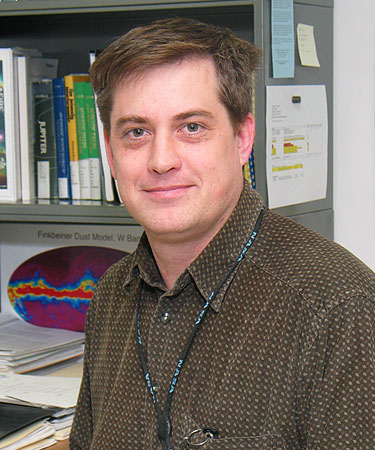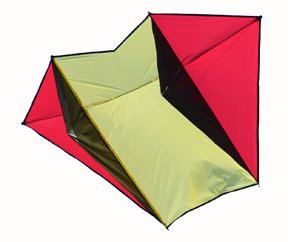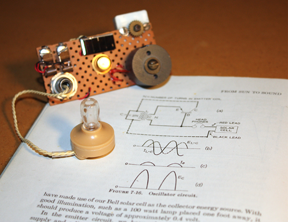Profile: Dr. Ed Wollack

Ed Wollack discovered very early on in life that he truly enjoyed making things, pondering over puzzles, and playing with light. Perhaps it's not surprising that these interests led him to become an astrophysicist, developing instruments that have helped see the edges of the known universe.
Biography
Ed was born in St. Paul, Minnesota, but grew up on a farm in rural Wisconsin. He attended the University of Minnesota's Institute of Technology. While studying architecture he took many math and physics courses, which led him to change his major. He graduated with honors in 1987 with a BS in Physics and a minor in mathematics. Ed went on to attend Princeton, where he earned a Ph.D. in physics in 1994. Ed's thesis focused on the measurement of the degree scale cosmic background radiation.
Post-PhD
After graduation, Ed worked at the National Radio Astronomy Observatory, Central Development Laboratory in Charlottesville, Virginia. While at NRAO he developed components and receivers for radioastronomy. He also helped design, characterize, and fabricate the High-Electron-Mobility-Transistor (HEMT) amplifiers used for the Wilkinson Microwave Anisotropy Probe (WMAP).
Current Work
Ed's research involves the development and use of precision imaging systems for astronomy. He still works on the WMAP, and is working on next generation experiments to measure the polarization of the cosmic microwave background and related questions.
Typical Day
There are many parts to Ed's day, but none of them seem to be "typical." There's a wide variety of big and little projects and responsibilities that are all happening concurrently. In fact, Ed says that what he enjoys most about his job is that he rarely does the same thing twice. Some of his projects are still works on paper and have been years in the making. All are little pieces of the big picture's puzzle that may take a while to come together. Part of his day is spent making measurements and documenting the results, put very simply.
"There are parts of astronomy and astrophysics that are extremely satisfying. I'm an astrophysicist, but I only spend about 10-30 percent of my time doing astrophysics. I spend the majority of my time working on building detectors and instruments. We figure out how to take light and process it and make images from it. Sometimes the problems can be very challenging, but challenging is good. It's like solving a mystery or puzzle."
There are other parts that involve fixing broken bits of equipment or understanding unexpected features in data. Sometimes, instrument calibration issues arise and he works with other members of the science team to understand them. Keeping these observations in the back of one's mind is an important aspect of formulating the next generation of instruments. But what Ed likes most is coming up with a new idea and carrying it forward to the prototype stage and onward.
How did you get interested in science?
Ed has always loved light, and science in general. As a child, he was fascinated with how light behaved, and made many of his own toys out of wood, plastic, and metal, including very simple robots. As others played with - and inevitably broke - the robots he made, he would keep rebuilding them. At some point, he says, he knew he'd succeeded when his friends played with them and they survived.
"I'd gotten to the level of proficiency where I could build things that could withstand exposure to other human beings. As a creator of something, you treat it with care. The best way to find out if something is going to break is to hand it to somebody else."
He has also always been interested in solar energy. After moving to a new school, one of his teachers gave him a book, "From Sun to Cell," written by a scientist from Bell Labs. The book came with a box, and inside it was a solar cell, transistor and transformer core. The box also contained wire, wax paper, and aluminum foil to make a transformer and capacitors to fashion a simple electrical circuit: a Colpitts oscillator. It made audible tones similar to a Theremin, an early electronic synthesizer. Playing with this and related circuits led to an fascination with radios.
He also had fun making electric motors, small planes and rockets, pin-hole cameras, and telescopes.
Ed loved making kites, which he considers a blend of art and function. His early ones where made from wood and paper. He later turned to sewn rip-stock nylon for most later versions. At one point he made a sled kite, with collapsable poles fashioned from antennas from a pair of discarded handheld radios. When folded, it fit in one's pocket. But when deployed it had an area of over a square meter. His success with the sled kite pointed him to the advantages of a parafoil, which is a kite that does not contain poles at all, for his later portable designs. Ed thinkgs that in exploring possible solutions it is important to be flexible and open to going down a new path. Later in life, he says, these experiences helped shape the way he solves problems - by breaking a something down into simple pieces one can understand the larger picture.
Other Interests
Ed enjoys art, music, and photography, which are three things that make use of another of Ed's interests: patterns. He also enjoys history and literature, and reads anything he can get his hands on. He will often read some of the books his wife brings home, including biographies of presidents and other famous men and women. Occasionally, his tastes gravitate toward the technical, and he will read the history and lives of people like Alexander Graham Bell, Nicola Tesla and Oliver Heaviside. He and his wife have two sons, ages 16 and 11. The family cat, a Russian blue named Phoenix, is widely believed to know the answers to the Universe but has respectfully declined to convey them.
Questions and Answers
Describe your research interests or goals.
Anything that allows me to look at things I don't understand, I find interesting. It could be an astrophysical question or a related instrumentation challenge. How can we use the properties of light to understand objects outside of our physical reach? What are the underlying limitations to such approaches? I am also interested in solving technological challenges which have direct applications to solving astrophysical questions. Part of what I like to do is bring excitement that I see about science, physics and astronomy and use it as a vehicle to talk to the public. I enjoy bringing the big picture to people. Why do we do astronomy? What is interesting? How does it change our world view? Can these developments be used by society at large?
If you weren't a scientist, what would you be?
In an early time think I would have done fine. The things I enjoy doing have an overlap with societal needs. I probably would end up being a craftsman of some sort. An observation: the scientists who know tend to perceive me as as an engineer at times - the engineers who know me think of me as a scientist. So if you're asking, "Could I be an engineer?" I could be, but it probably wouldn't be as satisfying to me. I see science as a process used to take a critical look at our environment to uncover and describe new information. A key element is asking refutable questions which lead to tests and observations which can be repeated by others. When things come together the unifying concepts can be elegant. Engineering, on the other hand, is the art of fulfilling a finite technological need within fixed resources. High value is given to doing it right the first time, safely meeting the stated end goals, and reliable service over intended product life. A high degree of creativity is clearly an important part of the process, however, not necessarily the end goal in itself. Clearly the scientific and engineering processes share common themes, however, at times the tension between their goals and approaches can be quite pronounced. If I were not a scientist, I would be a builder of things - a craftsman or artisan. I would be a machinist, cabinet maker, or carpenter.
What one question in science would you like to see answered in your lifetime?
Making me pick one would be pretty hard. I guess it would be, "Can we unify gravity with the other forces of nature?" But to be honest, I don't like the idea of picking one. There's a rich and almost limitless palette of questions to ponder. To be honest, what we presently understand is dwarfed by what we have yet to form as a well posed questions.
If time travel were possible, when and where would you visit, and why?
If I were a member of arbitrarily advanced civilization and I could travel in time (if that were possible) I would want to go back to talk to Michelangelo, and understand how he visualized the world. I would want to understand how he developed the spaces he developed, as well as the paintings and sculptures. I would want to ask him, "What was was your underlying motivation? What are the challenges you ran into with your patrons? How do you deal with carrying out your projects? How do you organize these projects? Did you have other visions which you were unable to fulfill?" We think of him as an individual, but some of the projects were clearly team efforts. I'd ask, "How do you make this happen?" Can I only make one such trip?
Who was your favorite teacher in school?
My high school band and jazz band instructor, Mr. Berg. He taught me the self-discipline which I needed to master in order to express myself musically. He also taught a class that I really enjoyed, music theory, which exposed me to the history of music. He used music as a vehicle to teach about the life, society, and the world.
Publication Date: January, 2011





